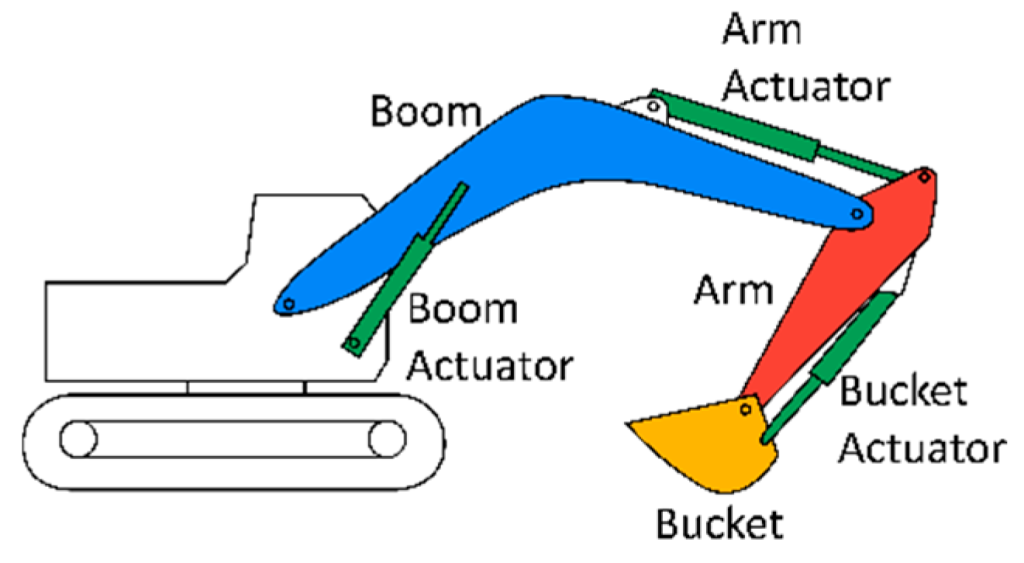Excavators are essential heavy machinery in construction and earthmoving industries. They are primarily used for digging, lifting, and moving materials. Understanding the parts of an excavator and their functions can help us appreciate the engineering behind this powerful machine. Below, we explore the key components of an excavator and how they work together to accomplish various tasks.
excavator diagram

Main Components of an Excavator
Here’s a breakdown of the crucial parts of an excavator:
- Cab
- The cab is the operator’s compartment, where controls are located. It is designed for visibility and comfort, often equipped with air conditioning and ergonomic seats.
- Boom
- The boom is the long arm that extends from the excavator’s body. It provides the height and reach necessary for digging and lifting.
- Stick (or Arm)
- Attached to the boom, the stick connects to the bucket. It provides additional reach and maneuverability, allowing the operator to dig deeper or farther away from the machine.
- Bucket
- The bucket is the primary tool used for digging. It comes in various shapes and sizes, depending on the job requirements. Buckets can be designed for digging, grading, or even specific materials like rocks or clay.
- Tracks (or Wheels)
- Excavators can be either tracked or wheeled. Tracks provide better stability and traction on uneven terrain. They distribute the machine’s weight, reducing ground pressure and preventing sinking into soft soil.
- Counterweight
- The counterweight is located at the back of the excavator. It balances the machine during operation, especially when the boom is extended. This is crucial for maintaining stability and preventing tipping.
- Hydraulic System
- The hydraulic system powers the excavator’s movements, allowing for precise control of the boom, stick, and bucket. This system uses hydraulic fluid to transmit force, making it possible to lift heavy loads with ease.
- Swing Mechanism
- The swing mechanism allows the upper structure of the excavator to rotate 360 degrees. This feature enables the operator to dig or move materials without repositioning the entire machine.
- Engine
- The engine powers the excavator, typically a diesel engine that provides the necessary horsepower to operate the hydraulic system and other components.
- Control System
- The control system includes levers and pedals that allow the operator to control the various functions of the excavator. This can be manual or, in more advanced models, electronic controls.
How Excavators Work
Excavators operate through a combination of hydraulic power and mechanical components. Here’s how the process generally works:
- Hydraulic Power: When the operator moves the controls, hydraulic fluid is directed to specific cylinders, causing the boom, stick, and bucket to move in the desired direction.
- Digging and Lifting: The bucket digs into the ground when lowered and pulled back by the stick. This motion enables the excavator to scoop up earth or other materials.
- Swinging: Once the bucket is filled, the operator can swing the upper structure to reposition the load for dumping or moving to another location.
- Dumping: The bucket can be tilted to release its contents, allowing for efficient loading and unloading of materials.
Applications of Excavators
Excavators are incredibly versatile and used in various applications, including:
- Construction: Digging foundations, trenches, and basements.
- Mining: Extracting minerals and coal from the earth.
- Landscaping: Grading and moving soil for landscaping projects.
- Demolition: Taking down buildings and structures.
- Forestry: Removing trees and clearing land for development.

Conclusion
Excavators are powerful machines that play a vital role in the construction and earthmoving industries. Understanding their parts—such as the cab, boom, stick, bucket, and hydraulic system—helps us appreciate the complexity and efficiency of these machines. Whether for digging, lifting, or moving materials, excavators are indispensable tools that make large-scale projects possible. By mastering the functionality of each component, operators can maximize the performance of excavators, ensuring that projects are completed efficiently and safely.